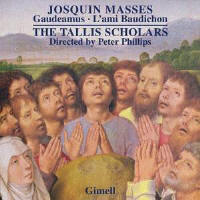Texte paru dans: / Appeared in: |
|
|
Outil de traduction ~ (Très approximatif) |
|
|
Reviewer: Barry
Brenesal
Peter Phillips continues
here his series devoted to Josquin’s complete Mass settings. As in the past,
he juxtaposes works in differing styles—what the conductor himself refers in
the liner notes to this release as “two different and yet compelling sound
worlds.” The relatively well known (among Josquin’s masses, at any rate)
Missa Gaudeamus is regarded as a product of the composer’s maturity, a work
of great variational skill and technical brilliance, with a side order for
those interested in mystical numerology. The Missa L’ami Baudichon, by
contrast, is sometimes listed as Josquin’s earliest surviving Mass, and has
drawn little attention to date.
Josquin scholar William Elders
spends a fair amount of space in his Josquin des Prez and his musical legacy
explaining some details of the numerical side of matters, of which this is a
fair sampling: “In the Gloria, the gaudeamus motif is found at the beginning
of all four voices. Thereafter it is repeated ten times in the tenor. When
he interpreted the number 14, Gregory the Great thought in terms of the
addition of the numbers 10 and 4, representing the Old Testament (from the
Decalogue) and the New (from the four Gospels)….” This is no idle
supposition; it was a popular Neo-Platonic method of relating all parts of
the Universe to one another and ultimately to God, that could prove of aid
during prayer and what we moderns would call meditation. It’s irrelevant as
a musical consideration, yet important in that the numerological edifice of
the Missa Gaudeamus demonstrates how Josquin (and some of his forebears)
triumphed over a self-imposed constraint upon his creative imagination.
The contemporary popularity of
this Mass can be judged in part by its survival in nine surviving
manuscripts and seven printed publications. Although scholars are far from
unified over the details of Josquin’s life and a timeline for his works,
several place it during the composer’s employment by the Vatican, 1489–1495.
Peter Philips suggests that it was possibly the ninth of the 18 settings
currently attributed to him, written roughly 20 years after his first. A
four-voiced paraphrase Mass, the head motif is regularly interacted with by
all the other parts, especially the chant’s first six notes. (The entire
chant is included, and like the theme of the Missa L’ami Baudichon, copied
in score with original text at the start of the liner notes.) The
craftsmanship is excellent, though nowhere as sustained in its bravura as in
the Agnus Dei, of which Philips quotes Elders describing as “a vertiginous
series of transpositions.”
L’ami Baudichon was a popular
folk song in France during the late 15th century, with a vulgarity that
would startle some modern listeners—although at least a few so-called
isorhythmic polytextual motets of the 14th century do this as well,
juxtaposing holy texts and those expressing earthy humor to envision the
range of celestial creation. Elders believes the Mass was written around
1475, in France, and displays musical elements influenced by Dufay. Josquin
does little with the head motif’s notes except restate, augment, and
occasionally invert them, all the attention being focused elsewhere. I find
myself agreeing with Philips that the final pages of the Credo are the
finest thing in the work, though the Credo’s first three restrained sections
are distinguished in themselves, while setting up the movement’s triumphant
conclusion.
Both works are performed in
standard SATB configuration with 10 voices. Peter Philips secures perfect
intonation and clarity out of his Tallis Scholars—a blend that never
conceals the individual parts, even in the most active portions of both
Masses. Phrasing is a delight, and the text impeccably enunciated.
The Missa Gaudeamus has been
recorded several times. Of those versions currently available, two stand
out. That of Bernard Fabre-Garrus with A Sei Voci features six male
vocalists and six children. This gives the whole a luminous feeling,
especially in the introit. Fabre-Garrus’s phrasing, as that of Philips, is
lovingly detailed. The recording was originally available on Astrée 8612,
then Naïve 8507, and finally as a six-CD set, Naïve 8906. I’ve seen both
Naïve versions online. The second recording of the Mass that strikes me as
especially fine is that featuring Walter Testolin and De Labyrintho
(Stradivarius 33722; Fanfare 30:1). J. F. Weber, who reviewed it, found the
performance’s “most striking aspect” that of “restraint.” I find it
possesses a rare sense of intimacy, in part a result of the restrained
louder end of dynamics Weber referred to, and also a heightening of
contrasting tempos between successive sections. Thus, the introit lingers,
while the Kyrie has an urgency that has seldom been matched in my
experience. There’s a hint of breathiness in the voices at times, such as at
the start of the Gloria, but not enough to detract from this excellent
reading.
The Missa L’ami Baudichon was
recorded previously by Peter Urqhart and Capella Alamire; and while it is
out of print, I have seen copies offered once again online. For me, the
beauty of tone and responsiveness of the singers is compromised by the use
of a sackbut to handle the cantus firmus. In short, there is some excellent competition from both Fabre-Garrus and Testolin that draws equal to Philips in the Missa Gaudeamus, but none I would count as attractive in the Missa L’ami Baudichon. With excellent sound, this comes highly recommended. | |
|
|
|
|
|
|
|
Cliquez l'un ou l'autre
bouton pour découvrir bien d'autres critiques de CD |
|




